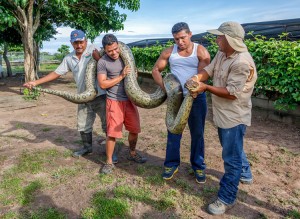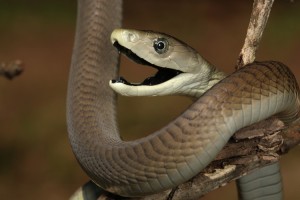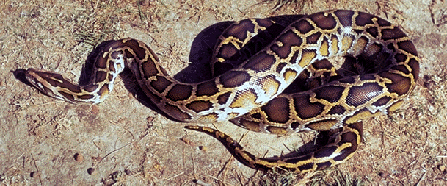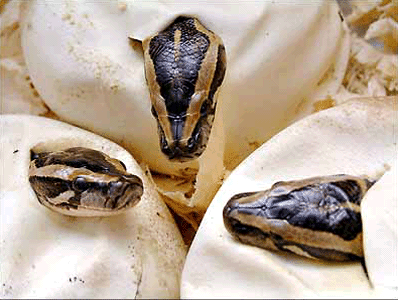Snakes with Feet or Flippers?
Wednesday, November 23rd, 2016November 23, 2016
At a recent convention of paleontologists (scientists who study animals and plants that lived in prehistoric times), things got a bit venomous. A group of researchers claimed that a fossil recently identified as an early snake was not a snake at all. Furthermore, they stated that the specimen should not have been studied in the first place. The presentation was the most recent shot fired in the battle over the evolution (a process of change over time) of snakes.
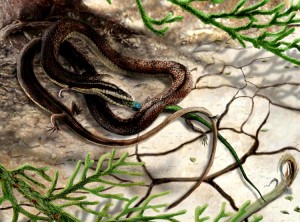
This artist’s impression shows the four-footed tetrapodophis amplectus snatching its prey, an unlucky salamander. Credit: © James Brown, University of Portsmouth
In 2015, Dave Martill and his colleagues at the University of Portsmouth in England reported that they had discovered a new type of primitive snake. They found the ancient animal’s fossilized imprint (which came from Brazil) among the collections of a German museum. The British researchers named their discovery Tetrapodophis amplectus and published their findings in the journal Science. Tetrapodophis means “four-footed snake.” The animal was about 6 inches (15 centimeters) long and possessed four tiny limbs. It lived in an ocean environment some 110 million years ago.
This month, however, at the annual Society of Vertebrate Paleontology conference in Salt Lake City, Utah, Michael Caldwell of the University of Alberta in Edmonton, Canada, gave a presentation refuting Martill’s “four-footed snake” diagnosis. In the creature’s skull, for instance, Caldwell noted “every single character that was identified in the original manuscript as being diagnostic of a snake was either not the case or not observable.” Instead, Caldwell’s group contended that Tetrapodophis is not a snake at all, but rather a member of a group of unrelated marine reptiles.
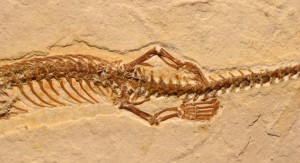
The fossilized imprint of Tetrapodophis reveals small, specialized feet—or perhaps flippers. Credit: © Dave Martill, University of Portsmouth
This dispute is merely the latest spat among paleontologists on snake origins. Paleontologists agree that snakes likely evolved in the Jurassic Period some 150 million years ago. Some people (like Martill) think that snakes evolved from aquatic reptiles. Over million of years, four-legged reptiles would have spent more and more time in the water, eventually losing their limbs in favor of a long body good for swimming. Later, snakes made their way onto land, with some (sea snakes) remaining in their ancestral habitat. Martill’s group contends that snakes were closely related to mosasaurs, giant marine reptiles that prowled the oceans some 100 million years ago. Most paleontologists, however, think that snakes evolved from burrowing, terrestrial reptiles. As these aimals dug deeper and more complex burrows with their strong heads, their limbs vanished over millions of years. Later, snakes moved into different habitats, including the sea. In this scenario, snakes’ closest relatives would be monitor lizards such as the Komodo dragon. So far, a lack of ancient snake fossils has prevented either hypothesis from being proven.
Further muddying the water, Caldwell—of the “land snake” faction—reported that when he went to study the fossil in the German museum, the fossil was no longer there. Apparently, it had been a loan to the museum from a private collector. The collector had retrieved it from the museum because it had been damaged during an earlier study. Most paleontologists will not study privately owned fossils for this exact reason: an owner may take back the fossil at any time. Science must be repeatable, so a description of a specimen that is no longer available for study is not science at all. Since Tetrapodophis was revealed to be a privately owned specimen, many experts have vowed to ignore it while conducting future studies on snake evolution. We will have to wait for more fossils—in the permanent collections of museums and universities—to determine if snakes started out on land or in the water—with four legs or, perhaps, four flippers.

